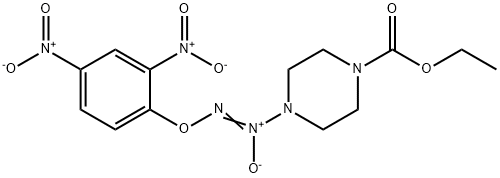| Identification | Back Directory | [Name]
JS-K | [CAS]
205432-12-8 | [Synonyms]
JS-K >=97%
1-Piperazinecarboxylic acid, 4-[2-(2,4-dinitrophenoxy)-1-oxidodiazenyl]-, ethyl ester | [Molecular Formula]
C13H16N6O8 | [MDL Number]
MFCD06407868 | [MOL File]
205432-12-8.mol | [Molecular Weight]
384.3 |
| Chemical Properties | Back Directory | [Melting point ]
140-141 °C | [Boiling point ]
546.7±60.0 °C(Predicted) | [density ]
1.60±0.1 g/cm3(Predicted) | [storage temp. ]
-20°C | [solubility ]
DMSO: 9.3 mg/mL, soluble | [form ]
A crystalline solid | [pka]
-7.23±0.20(Predicted) | [color ]
White to yellow |
| Hazard Information | Back Directory | [Uses]
JS-K is a NO donor that reacts with glutathione to generate NO at physiological pH. JS-K induces reactive oxygen species (ROS) to mediate apoptosis. JS-K induces autophagy. JS-K inhibits invasion. JS-K has a broad spectrum anti-proliferative activity in cancer cells. JS-K reduces tumor volume and causes necrosis of implanted tumors in mice[1][2]. | [Biochem/physiol Actions]
JS-K belongs to the class of diazeniumdiolate prodrug. It generates nitric oxide when metabolized by glutathione S-transferases (GST), which ensures optimal activity of JS-K. It has tumor growth inhibition action in human prostate cancer and leukemia. | [in vivo]
JS-K (1.54 mg/kg; i.v.; three times/week for 15-20 days) reduces tumor volume and causes necrosis of implanted tumors in mice [1].
| Animal Model: | NOD/SCID mice (6-8 weeks) (injected in the flanks s.c. with HL-60 or PPC-1 cells)[1] | | Dosage: | 1.54 mg/kg | | Administration: | Intravenous injection (i.v.), three times/week for 15-20 days | | Result: | Sixteen days after starting therapy, the average tumor volumes in vehicle and experimental group were 8.34 and 3.13 cm3, respectively, reflecting a > 50% reduction in tumor volume in experimental group.
Nineteen days after start of therapy, s.c. tumor implant volumes were 0.368 and 0.107 cm3 in vehicle and experimental group, respectively.
Revealed extensive cell necrosis in HL-60 (> 50%) and PPC-1 cell tumors.
Up to 1.54 mg/kg without observing significant hypotension, whereas doses of 1.54 mg/kg or higher has a notable hypotensive effect.
|
| [References]
[1] Shami PJ, et al. JS-K, a glutathione/glutathione S-transferase-activated nitric oxide donor of the diazeniumdiolate class with potent antineoplastic activity. Mol Cancer Ther. 2003 Apr;2(4):409-17. PMID:12700285
[2] Liu B, et al. JS-K, a nitric oxide donor, induces autophagy as a complementary mechanism inhibiting ovarian cancer. BMC Cancer. 2019 Jul 1;19(1):645. DOI:10.1186/s12885-019-5619-z
[3] Simeone AM, et al. TIMP-2 mediates the anti-invasive effects of the nitric oxide-releasing prodrug JS-K in breast cancer cells. Breast Cancer Res. 2008;10(3):R44. DOI:10.1186/bcr2095
[4] Dong R, et al. Effects of JS-K, a novel anti-cancer nitric oxide prodrug, on gene expression in human hepatoma Hep3B cells. Biomed Pharmacother. 2017 Apr;88:367-373. DOI:10.1016/j.biopha.2017.01.080 |
|
| Company Name: |
Sigma-Aldrich
|
| Tel: |
021-61415566 800-8193336 |
| Website: |
https://www.sigmaaldrich.cn |
| Company Name: |
Energy Chemical
|
| Tel: |
021-58432009 400-005-6266 |
| Website: |
http://www.energy-chemical.com |
| Company Name: |
|
| Tel: |
4008-099-669 |
| Website: |
http://m.is0513.com/ShowSupplierProductsList112975/0.htm |
| Company Name: |
Merck KGaA
|
| Tel: |
21-20338288 |
| Website: |
www.sigmaaldrich.cn |
|





